A scholarship fund set-up is a financial vehicle aimed at offering educational support to students who meet certain requirements.
Understanding Scholarship Funds
If you’re an individual donor wanting to make a difference, a family looking to honor a loved one’s memory, a corporation committed to boosting workforce development, or a community organization tackling educational inequities, starting a scholarship fund can truly leave a lasting mark by investing in education.
With the current cost of education on the rise worldwide, (university tuition has increased by 25% over the last decade), scholarship funds have become important in making sure that education remains within reach for everyone. Private scholarship funds contributed over $7.4 billion to students across the globe just in 2024 alone.
“Creating our family scholarship fund was initially daunting, but seeing the impact it’s had on 15 students over the past five years has been incredibly rewarding. The key was starting with clear goals and getting expert guidance early in the process.” — Maria Chen, Founder of the Chen Family First-Generation Scholarship
Types of Scholarship Funds You Can Set-Up
Before you dive into the setup process, it’s crucial for you to understand the various types of scholarship funds you can establish:
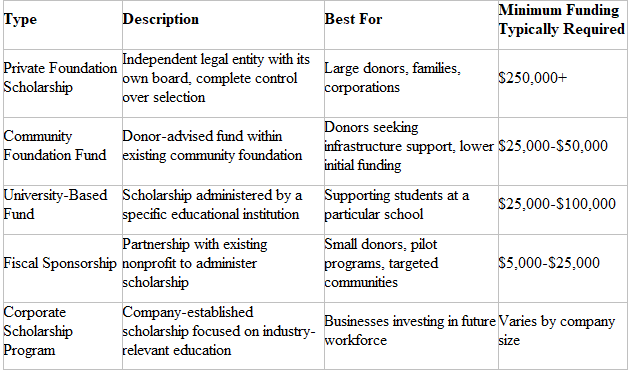
Guidelines to Scholarship Funds Set-up
Step 1: Define Your Scholarship’s Purpose and Vision
Core Questions to Answer:
Creating Your Mission Statement:
Setting Measurable Goals:

Step 2: Choose the Right Administrative Structure
Private Foundation
Key Requirements:
Community Foundation Fund
Process Overview:
Establishment Process:
Comparison Decision Matrix
Step 3: Establish Funding and Financial Requirements
Initial Funding Options
Endowed Fund:
Pass-Through Fund:
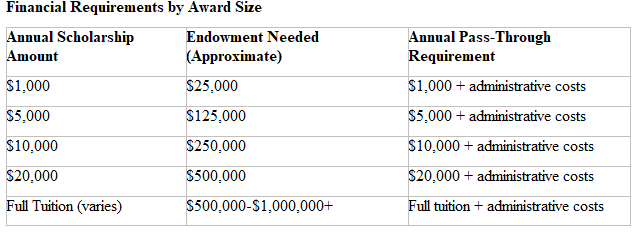
Investment Strategies for scholarship fund set-up
If you want to set up an endowed fund, here are points you should keep in mind:
⦁ Go for a conservative asset allocation to protect your principal
⦁ Interact with professional investment managers
⦁ Conduct regular reviews of your investment performance
⦁ Set up a spending policy (usually around 4-5% of average market value)
Fundraising Approaches
For those who want to grow or maintain scholarship funds, here are some tactics you should consider:
⦁ Start annual donation campaigns
⦁ Set up memorial or tribute giving programs
⦁ Consider corporate matching gift options
⦁ Organize fundraising events like galas or golf tournaments
⦁ Use online crowdfunding campaigns
⦁ Apply for grants from larger foundations
Step 4: Create Eligibility Criteria and Selection Process
⦁ Having clear eligibility criteria will ensure that your scholarship reaches the right candidates:
Common Eligibility Factors
Academic Factors:
⦁ Define GPA requirements (be clear on weighted or unweighted)
⦁ Specify standardized test score expectations
⦁ Note enrollment status (part-time or full-time)
⦁ Consider class rank
⦁ Identify the field of study
Demographic Factors:
⦁ Geographic location or residence
⦁ Financial need (make sure FAFSA is completed and adhere to income thresholds)
⦁ Status as a first-generation college student
⦁ Representation of underrepresented groups within certain fields
⦁ Connections to military service
Character and Achievement Factors:
⦁ Community service involvement
⦁ Leadership roles
⦁ Work experience
⦁ Participation in extracurricular activities
⦁ Unique talents or skills
Legal Consideration: While it’s fine for you to target scholarships to help tackle educational inequities, make sure to review your criteria with legal experts to stay compliant with non-discrimination laws.
Designing an Effective Selection Process
Selection Committee Structure:
⦁ Form a committee of 3-7 members with diverse viewpoints
⦁ Implement clear conflict of interest policies
⦁ Set term limits for committee members
⦁ Provide training on objective evaluation methods
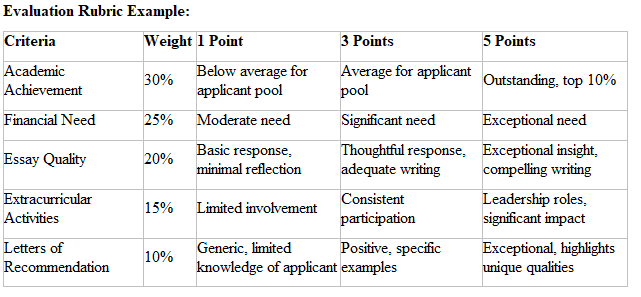
Step 5: Develop the Application Process
It’s important for you to create an application process that rightly balances between being comprehensive and user-friendly. Here are the key components you should include:
Essential Application Components for scholarship fund set-up
Basic Information:
⦁ Contact details
⦁ Educational background
⦁ Relevant demographic information for eligibility
Academic Documentation:
⦁ Transcripts (official or unofficial)
⦁ Standardized test scores (if required)
⦁ Verification of enrollment
Financial Information:
⦁ FAFSA status or other financial aid applications
⦁ Income documentation (if applicable)
⦁ Information on other scholarships and financial aid obtained
Personal Statements/Essays:
⦁ Targeted questions that align with the scholarship’s goals
⦁ Suggested word count (usually between 500-750 words)
⦁ Clear criteria for evaluation
Supporting Materials:
⦁ Letters of recommendation (generally between 1-3)
⦁ A resume or a list of activities
⦁ Portfolio examples (if applicable)
Application Timeline Best Practices
For Academic Year Scholarships:
⦁ Application Commencement: 8-10 months before the funds are needed
⦁ Application Deadline: 4-6 months before funds are required
⦁ Beneficiary Notification: 3-4 months before the funds are needed
⦁ Disbursed Funds: In line with academic terms
Sample Annual Timeline for scholarship fund set-up:
⦁ October: Application starts
⦁ February 1: Application deadline
⦁ March 15: Selection committee evaluates applications
⦁ April 1: The committee notifies beneficiaries
⦁ April 15: Beneficiaries confirm their acceptance
⦁ August/September: Disbursement of funds for the fall semester
Technology Options for scholarship fund set-up
Application Management Systems:
⦁ Scholarship management platforms (like SmarterSelect, WizeHive, Foundant)
⦁ Form builders (such as Formstack, JotForm, Google Forms)
⦁ Integration with a custom website
⦁ Email submission procedures
Cost Considerations:
⦁ Basic form systems: $0-$50 per month
⦁ Dedicated scholarship platforms: $1,000-$5,000 or more each year
⦁ Custom development: $5,000-$25,000 or more for initial setup
Step 6: Set Up Legal and Tax Considerations
It’s vital to have the right legal framework in place if you want to have tax advantages and maintain operational efficiency.
Tax-Exempt Status Options
501(c)(3) Private Foundation:
⦁ You’ll need to submit Form 1023
⦁ Expect a processing time of about 3 to 12 months
⦁ There’s a filing fee: $600
⦁ Annual tax return is done using Form 990-PF
Fund at Existing 501(c)(3):
⦁ You won’t need a separate IRS application
⦁ Enjoy immediate tax-exempt status
⦁ There’s an administrative fee to the host organization
Key Legal Documents Needed for scholarship fund set-up
For Private Foundations:
⦁ Articles of incorporation
⦁ Bylaws
⦁ Conflict of interest policy
⦁ Scholarship procedures document
⦁ Grant agreement template
⦁ Minutes from board meetings
For Community Foundation Funds:
⦁ Fund agreement
⦁ Scholarship criteria document
⦁ Advisory committee guidelines (if relevant)
Scholarship Tax Implications
For Donors:
⦁ Contributions to eligible scholarship funds are usually tax-deductible
⦁ Keep documentation handy for contributions over $250
⦁ There are specific rules for donor-advised funds and private foundations
For Recipients:
⦁ Scholarships which are meant for qualified educational expenses are usually tax-free
⦁ Make sure to report scholarships over $600 that aren’t used for tuition
⦁ Non-qualified expenses requires 1099 forms
Important: Make sure to always consult a tax professional who specializes in non-profit law to ensure that you’re following all the current regulations.

Step 7: Launch and Promote Your Scholarship Fund Set-up
If you want to attract quality applicants who align with your mission, then have a solid promotional strategy:
Marketing Channels by Target Audience
High School Students:
⦁ Connect through school guidance counselor networks
⦁ Use college and career counseling offices
⦁ Interact with college preparation programs
⦁ Reach out to youth organizations like the YMCA and Boys & Girls Clubs
⦁ Use social media platforms like Facebook, Instagram, X, and TikTok
College Students:
⦁ Tap into university financial aid offices
⦁ Communicate through academic departments
⦁ Collaborate with student organizations and clubs
⦁ Use campus career centres to spread the word
⦁ Partner with relevant professional associations
Graduate Students:
⦁ Connect through academic departments
⦁ Reach out to professional associations
⦁ Advertise in industry publications
⦁ Use research centres
⦁ Participate in professional conferences
Scholarship Listing Platforms
Major Scholarship Databases:
⦁ Fastweb
⦁ Scholarships.com
⦁ Cappex
⦁ College Board BigFuture
⦁ Chegg Scholarships
⦁ MyScholarhq.com
Niche-Specific Platforms:
⦁ Professional associations tailored to specific fields
⦁ Databases from community foundations
⦁ Regional compilations of scholarships
⦁ Resources from identity-based organizations
Launch Timeline
3-6 Months Before Launch:
⦁ Wrap up all your application materials
⦁ Get promotional content ready to go
⦁ Build that website or online presence
⦁ Set up social media accounts, if you plan to use them
1-3 Months Before Launch:
⦁ Reach out to your promotional partners
⦁ List your scholarship across various databases
⦁ Prep your press releases and announcements
⦁ Brief your key stakeholders on how the referral process will work
Launch Period:
⦁ Organize webinars to provide info and answer questions
⦁ Connect with potential applicants on social media
⦁ Keep an eye on inquiries and respond in a timely manner
⦁ Track how many applications you’re getting
Step 8: Manage and Sustain Your Scholarship Fund
To guarantee long-term success, you’ve got to stay on top of administration and growing your fund:
Annual Administrative Calendar
Pre-Application Period:
⦁ Take a look at your eligibility criteria and make any necessary updates
⦁ Keep your application materials up-to-date
⦁ Confirm your selection committee members
⦁ Plan a timeline for the next cycle
Application Review Period:
⦁ Process those applications
⦁ Hold selection committee meetings
⦁ Verify info for your finalists
⦁ Notify both recipients and non-recipients
Award Period:
⦁ Collect confirmations of acceptance from your recipients
⦁ Verify their enrollment
⦁ Process the scholarship disbursements
⦁ Get stories and information from your recipients
Post-Award Period:
⦁ Collect data on the impact of your scholarships
⦁ Prepare reports for donors and stakeholders
⦁ Conduct fundraising efforts, if you need to
⦁ Do some financial review and planning
Measuring Impact
Short-Term Metrics:
⦁ The number of applications you’ve received
⦁ Geographic and demographic diversity of applicants
⦁ Financial need addressed
⦁ Academic achievements of your recipients
Long-Term Metrics:
⦁ Graduation and completion rates
⦁ Career placement success stories
⦁ Advanced degree accomplishments
⦁ Contributions to the community
⦁ Engagement from alumni
Growth Strategies
Financial Growth:
⦁ Set up planned giving programs
⦁ Start endowment campaigns
⦁ Promote corporate partnerships
⦁ Support alumni giving initiatives
Program Growth:
⦁ Broaden eligibility criteria
⦁ Raise award amounts
⦁ Introduce additional support like mentoring and internships
⦁ Build a strong alumni network
Succession Planning
To ensure long-term sustainability, make sure to:
⦁ Create a detailed procedures manual
⦁ Document decision-making processes
⦁ Provide training for new committee members
⦁ Develop a leadership transition plan
⦁ Consider legacy factors
Cost Breakdown: What to Budget For
Understanding all associated costs helps ensure sustainable operations:
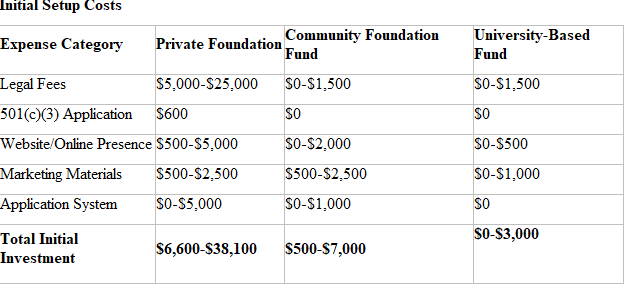
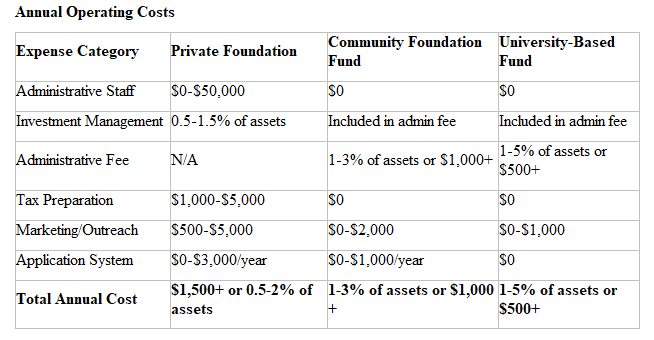
Real Examples: Successful Scholarship Fund Set-Up
Learning from established scholarship programs provides valuable insights:
Small Family Foundation Scholarship Fund Set-up
The Richardson Family Scholarship
⦁ Started with: $200,000 endowment
⦁ Structure: Private foundation
⦁ Focus: First-generation college students from rural areas
⦁ Awards: 4 awards of $2,500 each year
⦁ Unique Feature: Offers mentorship from family members and previous recipients
⦁ Growth: Increased to a $350,000 endowment after 12 years
Key Lesson: “Starting small but with a clear focus allowed us to make a meaningful difference in a specific community rather than trying to solve every educational need.” — James Richardson, Founder
Corporate Scholarship Fund Set-up
TechFuture Scholarship by InnovateX
⦁ Started with: $75,000 annual investment
⦁ Structure: Corporate-managed program
⦁ Focus: Underrepresented students in computer science and engineering
⦁ Awards: 15 awards of $5,000 each year
⦁ Unique Feature: Includes a paid summer internship
⦁ Impact: 78% of recipients are now working in the tech industry
Key Lesson: “Aligning our scholarship with our talent pipeline needs created a win-win for both students and our company’s long-term growth.” — Maria Valdez, InnovateX HR Director
Community Foundation Scholarship Fund Set-up
Westside Educational Opportunity Fund
⦁ Started with: $50,000 donor-advised fund
⦁ Structure: Fund at a local community foundation
⦁ Focus: Need-based scholarships for local residents
⦁ Awards: Amount varies based on need ($1,000-$5,000)
⦁ Unique Feature: Selection committee made up of community members
⦁ Growth: Now exceeds $200,000 after 7 years of community fundraising
Key Lesson: “The community foundation’s infrastructure allowed us to focus on relationship-building and student support rather than administrative details.” — Community Fund Advisory Committee

Common Challenges in Scholarship Fund Set-up and Overcoming Them
Challenge: Insufficient Quality Applications
Solutions:
⦁ Reassess eligibility criteria for any barriers
⦁ Broaden promotional efforts
⦁ Streamline application process
⦁ Offer application assistance
⦁ Interact with past recipients as ambassadors
Challenge: Difficulty Selecting Among Qualified Applicants
Solutions:
⦁ Fine-tune the rubric using weighted criteria
⦁ Introduce a multi-step selection process
⦁ Include interviews for the finalists
⦁ Increase the number of scholarships if the budget allows it
⦁ Set up runner-up awards or create second chance opportunities
Challenge: Administrative Burden
Solutions:
⦁ Leverage scholarship management software
⦁ Team up with educational institutions to handle administration
⦁ Simplify the renewal requirements
⦁ Consider offering awards for multiple years
⦁ Craft a comprehensive procedures manual
Challenge: Fund Sustainability
Solutions:
⦁ Set up an endowment with a portion of the funds
⦁ Diversify funding sources
⦁ Launch matching gift programs
⦁ Provide options for planned giving
⦁ Interact with recipients as future donors
Challenge: Measuring Long-Term Impact
Solutions:
⦁ Develop alumni tracking system
⦁ Conduct annual or bi-annual surveys
⦁ Organize events or reunions for recipients
⦁ Build an online community for recipients
⦁ Collaborate with educational institutions for data collection
Scholarship Fund Setup Checklist
Use this handy checklist to make sure you cover all essential points when starting a scholarship fund:
Planning Phase
⦁ Clearly define the purpose and vision of the scholarship
⦁ Establish eligibility criteria
⦁ Determine how much to award and how often
⦁ Choose the administrative structure
⦁ Budget for both setup and ongoing operations
⦁ Develop a timeline for launching the fund
Legal and Financial Setup
⦁ Consult with legal and tax experts
⦁ Choose an administrative platform or partner
⦁ Complete all necessary legal filings
⦁ Open banking or investment accounts
⦁ Draft a fund agreement or governing documents
⦁ Create an investment strategy if you’re establishing an endowment
Application Process Development
⦁ First up, create an application form along with the necessary requirements.
⦁ Next, establish a set of evaluation criteria and a rubric to guide selection.
⦁ Gather a selection committee to handle the reviews.
⦁ Don’t forget to develop policies for managing conflicts of interest.
⦁ Make a recipient agreement template to outline the terms clearly.
⦁ Finally, set up procedures for how the funds will be disbursed.
Marketing and Promotion
⦁ Start by creating a branding identity for the scholarship.
⦁ Design a dedicated website or an online presence to gain visibility.
⦁ Develop promotional materials to spread the word
⦁ Make sure to submit the scholarship details to various scholarship databases
⦁ Work together by establishing outreach partnerships
⦁ Create a social media strategy to reach a broader audience if it’s relevant.
Operational Systems
⦁ Develop a clear process for reviewing applications.
⦁ Establish a reliable system for keeping records.
⦁ Prepare templates for communicating with recipients.
⦁ Put together an annual calendar to outline your activities.
⦁ Establish metrics to measure the impact of your scholarship.
⦁ Finally, design reporting templates for stakeholders to keep everyone informed.

Frequently Asked Questions
Q: What is the minimum amount needed to start a scholarship fund?
A: The minimum can vary depending on the structure. Community foundations usually start their funds around $25,000-$50,000, while private foundations often require a hefty $250,000 or more to cover administrative costs. Some universities offer named scholarship opportunities starting at around $25,000, while you can set up pass-through scholarships for as little as $1,000-$5,000 a year.
Q: Can I specify exactly who receives my scholarship?
A: While you can set eligibility criteria, directly choosing the recipients might put your tax-deductible status at risk. It’s generally best to establish clear criteria and let an independent selection committee handle the final choices, especially if donors are involved.
Q: How long does it take to set up a scholarship fund?
A: The timeline really depends on the structure you choose. If you’re going through a community foundation, you might get things rolling in just 2 to 4 weeks. University-based funds typically take between 1 to 3 months, and private foundations can take a while longer.
Q: Can I require scholarship recipients to work for my organization?
A: If your scholarships come with a service requirement, they might be viewed as taxable income instead of tax-exempt educational help. It’s generally better to provide internship or job opportunities that recipients can choose to accept rather than making service mandatory.
Q: What percentage of my donation goes to students versus administration?
A: The costs of administration can differ based on the type of organization. Community foundations typically take about 1-3% of assets every year. Private foundations might have higher overhead, ranging from 5-10% of their annual distributions. University-affiliated funds tend to charge administrative fees between 1-5%.
Q: Can I set up a scholarship fund in memory of someone?
A: Absolutely! Memorial scholarships are quite popular. They honor the legacy of a loved one by aiding education in areas they cherished or addressing causes close to their heart. Many donors align the eligibility criteria with what the honoree valued, their career, or personal traits.
Q: How can I ensure my scholarship continues after my lifetime?
A: The best way is to create an endowment fund with thoughtful succession planning. Make sure to document your wishes, name future fund advisors or administrators, and think about including scholarship details in your estate plan. Community foundations and universities are there to help manage these funds in the long run.
Q: Is it better to offer fewer large scholarships or more small scholarships?
A: It really depends on what you want to achieve. Larger scholarships (think $5,000 or more) can significantly influence student enrollment choices and help alleviate their debt. Meanwhile, smaller scholarships (around $500 to $1,000) enable you to assist a greater number of students, although the impact on any one individual might be less pronounced. Some funds start with smaller awards that have the potential to grow over time.
Resources and Additional Support
Professional Assistance
Legal Resources:
⦁ Foundation Group: They specialize in helping with nonprofit formation.
⦁ National Scholarship Providers Association (NSPA): Your go-to for legal resources and best practices.
⦁ Local legal aid groups that provide support for nonprofits.
Financial Administration:
⦁ Consult the Council on Foundations for comprehensive guidance, rely on the National Association of College and University Business Officers (NACUBO) for college-related business matters, and utilize Foundation Source for services specifically designed for private foundations.
Educational Resources
Books and Publications:
⦁ “Starting and Managing a Nonprofit Organization” by Bruce R. Hopkins is a must-read.
⦁ “Establishing Your Scholarship: A Step-by-Step Guide” by NSPA for practical insights.
⦁ Don’t miss “The Complete Guide to Planned Giving” by Debra Ashton. It’s value-packed.
Online Resources:
Access the Council on Foundations for resources tailored to private and family foundations, utilize the National Scholarship Providers Association for best practices and tools, and explore Foundation Center (now Candid) for insightful research on existing scholarship programs.
Networking Opportunities
Professional Associations:
Join the National Scholarship Providers Association (NSPA) to connect with peers, become a member of the Council on Foundations, and engage with the Association of Fundraising Professionals for vital networking opportunities.
Events and Conferences:
Attend the NSPA Annual Conference, join regional community foundation events to connect with peers, and participate in higher education advancement conferences to expand your network and knowledge.


